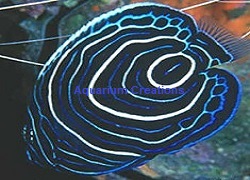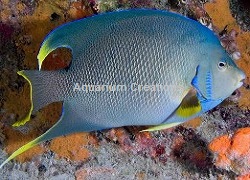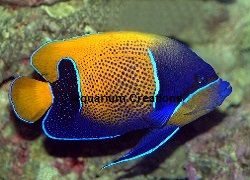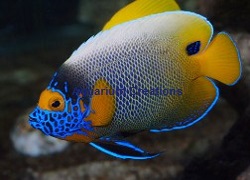Easy
- Asfur Angelfish, Pomacanthus asfur
- Black Velvet, Gray Poma Angelfish, Chaetodontoplus melanosoma
- Maculosus Angelfish, Pomacanthus maculosus
- Passer Angelfish, Holacanthus passer
- Queen Angelfish, Holacanthus ciliaris
- Xanthurus (Cream) Angelfish, Apolemichthys xanthurus
x
x
x
x
x
x
x
X
x
x
X
x
|
Moderate
- Annularis Angelfish, Pomacanthus annularis
- Black Angelfish (Grey) Angelfish, Pomacanthus arcuatus
- Blueline Angelfish, Chaetodontoplus septentrionalis
- Blueface Angelfish, Pomacanthus xanthometopon
- Blue Angelfish, Holacanthus bermudensis
- Chrysurus Angelfish, Pomacanthus chrysurus
- Cortez Angelfish, Pomacanthus zonipectus
- Emperor Angelfish, Pomacanthus imperator
- False Personifer Angelfish, Chaetodontoplus meredithi
- French Angelfish, Pomacanthus paru
- Goldflake Angelfish, Apolemichthys xanthopunctatus
- Griffis Angelfish, Apolemichthys griffisi
- Joculator Angelfish, Centropyge joculator
- Koran Angelfish, Pomacanthus semicirculatus
- Majestic Angelfish, Blue Girdled Angelfish, Pomacanthus navarchus
- Scribbled Angelfish, Chaetodontoplus duboulayi
- Spotbreast (Swallowtail) Angelfish, Genicanthus melanospilos
- Zebra Lyretail Angelfish, Genicanthus caudovittatus
|
Difficult
- Black Bandit Angelfish, Apolemichthys arcuatus
- Bluespotted Angelfish, Chaetodontoplus caeruleopunctatus
- Regal Angelfish, Pygoplites diacanthus
- Rock Beauty Angelfish, Holacanthus tricolor
- Singapore Angelfish, Chaetodontoplus mesoleucus
- Six Bar Angelfish, Pomacanthus sexstriatus
- Watanabei Angelfish, Genicanthus watanabei
x
x
x
x
x
x
X
x
x
x
|
Aquarium Conditioned
Queen Angelfish
Holocanthus ciliaris

Description:
The queen angelfish (Holacanthus ciliaris) is a large and hardy angelfish commonly found near reefs in the warmer sections of the western Atlantic Ocean. Since they come from the Caribbean, the Queen Angelfish can handle water temperatures a little higher than some other large angels. Temperature can be safely up to 82 degrees for the Queen of the Caribbean. Queen angelfish get their royal title from the speckled, blue-ringed black spot on their heads that resembles a crown. Queen angels are among the most strikingly colorful of all reef fishes. They are shy fish, found either alone or often in pairs. If you order a Juvenile Queen Angelfish, the Small size will be in total Juvenile colors and pattern. The Medium and Large Juvenile will have a coloration and pattern a mixture of the Juvenile and Adult.
Tank Recommendations:Fairly large they can grow up to 18 inches in length. Large angelfish require large real estate. If you deny your queen angel the size aquarium his species requires, there will be health problems. The psychological stress which comes from a saltwater fish not having its necessary size will often show in a break down of the immune response leading to disease. Your angelfish requires a mature tank where algae is growing well, lots of live rock and a fine sand or coral rubble substrate.
Reef Compatibility: Will nip at sessile invertebrates such as nudibranchs, corals, and clams.
Food and diet: Feed your fish 2 or 3 Times a Day. Feed only proper Angelfish foods that contain vitamin supplements. We use Ocean Nutritions Frozen sponge based food called "Angel Formula". Especially formulated for marine Angelfish Ocean Nutritions frozen food blend contains their primary natural food, namely marine sponges, combined with fresh seafood, oyster meat, scallop roe, fresh seaweed Spirulina, and Nori. We also use and recommend Hikari's Mega Marine Angel food. It includes Sponge, sea algae, sea urchin, sea worms, plankton, krill, shrimp, clam, mussel, squid, spirulina, algae extract, and cod liver oil. Both are excellent frozen foods.
Level of Care: Moderate
Acclimaton Time: 3+ hours
Approximate Size: Juvenile Small: 1" to 1-1/2"; Medium: 1-1/2" to 2"; Large: 2" to 3" Adult Small: 3" to 3-1/2"; Medium: 3-1/2" to 5"; Large: 5" to 6"; XLarge: 6quot; to 7"; XXLarge: 7" to 8";
|
Juvenile
Small $199.99
Medium $249.99
Large $299.99
Adult
Small $319.99
Medium $269.99
Large $429.99
XLarge $489.99
|
|
Aquarium Conditioned
Juvenile Imperator Angelfish
Pomacanthus imperator(Indo Pacific)

Description:
The Emperor Angelfish is also called the Imperator Angelfish or Imperial Angel. Like two different fish, adult and juvenile emperor angelfish look completely different. It was once thought that the two forms were two completely different species. The body of the juvenile is a dark bluish black. It has a light blue line near the tail with a white circle around it. This white circle is surrounded by alternating light blue and white incomplete circles. When the juvenile reaches a length of between 4 and 5 inches its colors will completely change.
Minimum tank size:
Provide a 90 gallon or larger as a juvenile. If you are planning on keeping the same aquarium when the Emperor Angelfish grows up since the Imperator angelfish will grow to roughly 16 inches in the wild it will need a much larger tank. If you deny your Imperator Angel the size aquarium his species requires, there is a good possibility of future health problems. The psychological stress which comes from a saltwater fish not having its necessary size will often show in a break down of the immune response leading to disease. Give your Imperator a 220 gallon+ mature tank where algae is growing well, lots of live rock for grazing, shelter, and territory. Along with a live sand substrate for the angel to snack on benthic invertebrates in the sand.
Reef Compatibility:
Will nip at sessile invertebrates such as nudibranchs,corals, and clams.
Food and diet: Feed your fish 2 or 3 Times a Day. Feed only proper Angelfish foods that contain vitamin supplements. Large Angelfish must get vitamin b12, vitamin d3, vitamin e, beta carotene, riboflavin, biotin, and niacin. We use Ocean Nutritions Frozen sponge based food called "Angel Formula". Especially formulated for marine Angelfish Ocean Nutritions frozen food blend contains their primary natural food, namely marine sponges, combined with fresh seafood, oyster meat, scallop roe, fresh seaweed Spirulina, and Nori. We also use and recommend Hikari's Mega Marine Angel food. It includes Sponge, sea algae, sea urchin, sea worms, plankton, krill, shrimp, clam, mussel, squid, spirulina, algae extract, and cod liver oil. Both are excellent frozen foods.
Level of Care: Moderate
Acclimaton Time: 3+ hours
Approximate Purchase Size: Juvenile Small: up to 2"; Medium: 2" to 2-1/2"; Large: 2-1/2" to 3-1/4";
|
Small $119.99
Medium $139.99
Large $169.99
Changing to Adult $229.99
|
|
Aquarium Conditioned
Adult Imperator Angelfish
Pomacanthus imperator,(Indo Pacific)

Description:
The Imperator Angelfish (Pomacanthus imperator) is also known as Imperial Angelfish and Emperor Angelfish. The name is commonly shortened to Emperor Angel / Imperial Angel / Imperator Angel in everyday speech. The adult fish is blue and decorated with close-set horizontal yellow stripes on the sides and the adjoining dorsal and anal fins. The caudal fin is of a striking yellow to orange shade. The eye is enclosed by a black vertical bar with blue edging. The pectoral fin base is black while the snout is white.
Minimum tank size:
An adult Imperator angelfish will grow to roughly 16 inches in the wild. If you deny your Imperator Angel the size aquarium his species requires, there is a good possibility of future health problems. The psychological stress which comes from a saltwater fish not having its necessary size will often show in a break down of the immune response leading to disease. Give your Imperator a 220 gallon+ tank. Last keep in mind your angelfish requires a mature tank where algae is growing well, lots of live rock for grazing, shelter, and territory. Along with a live sand substrate for the angel to snack on benthic invertebrates in the sand.
Reef Compatibility:
Will nip at sessile invertebrates such as nudibranchs,corals, and clams.
Food and diet: Feed your fish 2 or 3 Times a Day. Feed only proper Angelfish foods that contain vitamin supplements. Large Angelfish must get vitamin b12, vitamin d3, vitamin e, beta carotene, riboflavin, biotin, and niacin. We use Ocean Nutritions Frozen sponge based food called "Angel Formula". Especially formulated for marine Angelfish Ocean Nutritions frozen food blend contains their primary natural food, namely marine sponges, combined with fresh seafood, oyster meat, scallop roe, fresh seaweed Spirulina, and Nori. We also use and recommend Hikari's Mega Marine Angel food. It includes Sponge, sea algae, sea urchin, sea worms, plankton, krill, shrimp, clam, mussel, squid, spirulina, algae extract, and cod liver oil. Both are excellent frozen foods.
Level of Care: Moderate
Acclimaton Time: 3+ hours
Approximate Purchase Size: Medium 3" to 4"; Medium/Large 4" to 5"; Large: 5" to 6" ; XLarge: 6" to 71/2", XXL 7-1/2" to 8-1/2"
|
Medium $399.99
Medium/Large $499.99
Large $599.99
XLarge $699.99
XXLarge $849.99
|
|
Aquarium Conditioned
Blue Angelfish
Holacanthus bermudensis

Description: The Blue angelfish, Holacanthus bermudensis, is a species of marine angelfish of the family Pomacanthidae. Holocanthus bermudensis should not be confused with Holocanthus ciliaris, or queen angelfish, despite very similar appearances. The Blue Angel has a “crown”, but not as clear as the Queen Angelfish. The markings of both are very close. The Blue Angelfish is purplish to blue the edges of the scales are paler. Dorsal, anal and tail fins have yellowish-brown dots and yellow trim. Ventral fin is yellow with blue trim and the pectoral fins are exactly the opposite – blue with yellow trim. If you order a Juvenile Blue Angelfish, the Small size will be in total Juvenile colors and pattern. The Medium Juvenile and the Large Juvenile will be changing so the coloration and pattern will be a mixture of the Juvenile and Adult.
Tank Recommendations: Large angelfish require large real estate. A Blue angelfish will grow to around 16 to 18 inches. If you deny your Blue angel the size aquarium his species requires, there will be health problems. The psychological stress which comes from a saltwater fish not having its necessary size will often show in a break down of the immune response leading to disease. Your angelfish requires a mature tank where algae is growing well, lots of live rock and a fine sand or coral rubble substrate.
Reef Compatibility: Will nip at sessile invertebrates such as nudibranchs, corals, and clams.
Food and diet: Feed your fish 2 or 3 Times a Day. Feed only proper Angelfish foods that contain vitamin supplements. Large Angelfish must get vitamin b12, vitamin d3, vitamin e, beta carotene, riboflavin, biotin, and niacin. We use Ocean Nutritions Frozen sponge based food called "Angel Formula". Especially formulated for marine Angelfish Ocean Nutritions frozen food blend contains their primary natural food, namely marine sponges, combined with fresh seafood, oyster meat, scallop roe, fresh seaweed Spirulina, and Nori. We also use and recommend Hikari's Mega Marine Angel food. It includes Sponge, sea algae, sea urchin, sea worms, plankton, krill, shrimp, clam, mussel, squid, spirulina, algae extract, and cod liver oil. Both are excellent frozen foods.
Level of Care: Easy
Acclimaton Time: 3+ hours
Approximate Purchase Size:
Juvenile Small: 1" to 1-1/2"; Medium: 1-1/2" to 2"; Large: 2" to 3"
Adult Small: 2" to 3"; Medium: 3" to 4"; Large: 4" to 6"; XLarge: 6" to 7"; XXLarge: 7" to 8";
|
Juvenile Small $129.99
Medium $149.99
Large $219.99
Medium $259.99
Large $329.99
XLarge $399.99
XXLarge $469.99
|
|
Aquarium Conditioned
Majestic Angel / Blue Girdled Angelfish
Euxiphipops navarchus

Description:
The Majestic Angelfish is one of the more mellow large angelfish and usually does not display aggression towards its tankmates, with the possible exception of other large angels and conspecifics introduced after it has established itself. One of the smaller full size angelfish, it reaches a maximum adult size of approximately 10 inches, is a slow grower, and will rarely attain this size in an aquarium.
Tank Recommendations: A Majestic angelfish will grow to around 10 inches. If you deny your Majestic angel the size aquarium his species requires, there will be health problems. The psychological stress which comes from a saltwater fish not having its necessary size will often show in a break down of the immune response leading to disease. Your angelfish requires a mature tank where algae is growing well, lots of live rock and a fine sand or coral rubble substrate.
Reef Compatibility: Will nip at sessile invertebrates such as nudibranchs, corals, and clams.
Food and diet: Feed your fish 2 or 3 Times a Day. Feed only proper Angelfish foods that contain vitamin supplements. Large Angelfish must get vitamin b12, vitamin d3, vitamin e, beta carotene, riboflavin, biotin, and niacin. We use Ocean Nutritions Frozen sponge based food called "Angel Formula". Especially formulated for marine Angelfish Ocean Nutritions frozen food blend contains their primary natural food, namely marine sponges, combined with fresh seafood, oyster meat, scallop roe, fresh seaweed Spirulina, and Nori. We also use and recommend Hikari's Mega Marine Angel food. It includes Sponge, sea algae, sea urchin, sea worms, plankton, krill, shrimp, clam, mussel, squid, spirulina, algae extract, and cod liver oil. Both are excellent frozen foods.
Level of Care: Moderate
Acclimaton Time: 3+ hours
Approximate Purchase Size:
Small 1-1/ 2" to 3"; Medium 3" to 4"; Large: 4" to 6" ; XLarge: 6" to 7"
|
Medium $249.99
Large $299.99
XLarge $359.99
XXLarge $439.99
|
|
Aquarium Conditioned
Blue Face Angelfish
Pomacanthus xanthometopon

Identification:
The Blueface Angelfish is a solitary species known from coral-rich areas of channels, lagoons, and outer reef slopes, often in close proximity to caves. It has many names called the Blue face Angelfish, Blue faced Angelfish, Blueface Angelfish, Bluefaced Angelfish, Yellow face Angelfish, Yellowface Angelfish, and Yellowmask Angelfish. The Blueface Angelfish occurs in the Indo-Pacific,inhabits lagoon, channels and outer reef slopes with prolific algae growth.
Tank Recommendations: A Blue Face Angelfish will grow to around 15 inches. If you deny your Blueface angel the size aquarium his species requires, there will be health problems. The psychological stress which comes from a saltwater fish not having its necessary size will often show in a break down of the immune response leading to disease. Your angelfish requires a mature tank where algae is growing well, lots of live rock and a fine sand or coral rubble substrate.
Reef Compatibility: Will nip at sessile invertebrates such as nudibranchs, corals, and clams.
Food and diet: Feed your fish 2 or 3 Times a Day. Feed only proper Angelfish foods that contain vitamin supplements. Large Angelfish must get vitamin b12, vitamin d3, vitamin e, beta carotene, riboflavin, biotin, and niacin. We use Ocean Nutritions Frozen sponge based food called "Angel Formula". Especially formulated for marine Angelfish Ocean Nutritions frozen food blend contains their primary natural food, namely marine sponges, combined with fresh seafood, oyster meat, scallop roe, fresh seaweed Spirulina, and Nori. We also use and recommend Hikari's Mega Marine Angel food. It includes Sponge, sea algae, sea urchin, sea worms, plankton, krill, shrimp, clam, mussel, squid, spirulina, algae extract, and cod liver oil. Both are excellent frozen foods.
Level of Care: Moderate
Acclimaton Time: 3+ hours
Approximate Purchase Size:
Juvenile: uo to 2" Adult Small: 2" to 3"; Medium: 3" to 4"; Large: 4" to 6"; XLarge: 6-1/2" to 7-1/2": XXLarge: 8" to 10"
|
Juvenile $149.99
Small $249.99
Medium $349.99
Large $419.99
XLarge $499.99
XXLarge $999.99
|
|
Copyright 09/2021 Aquarium Creations Online
Photos are representative of each species. All marine life will be unique and variations should be expected, colors and sizes may vary.
|
|






